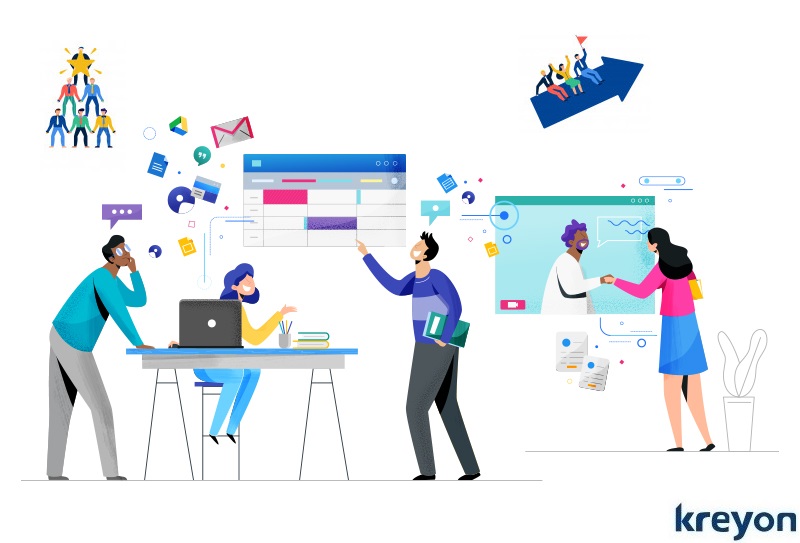Why Adopt Design Thinking for Business Management

Design thinking for business has become a strategic tool. Many organisations around the world use design thinking to improve team interactions, create inclusiveness, empathise with customers, facilitate innovation, solve problems and achieve desired goals by aligning teams.
Design thinking has emerged as a potent force to streamline processes for organisational transformation. It offers a solid framework for experimentation and getting rid of unwanted surprises. Here’s how design thinking for business management helps in building dynamic and constructive processes.
1. Creative Enterprise
With design thinking, organisations are well equipped with a step by step guide to experiment, connect and bring teams together for solving problems. This approach creates a flat structure where the emphasis is on building and unleashing the best solutions for the customers.
The design thinking process helps teams interact more effectively using visuals. It helps teams exchange ideas tangibly and increases overall understanding to solve the right problems. Design thinking approach clarifies the end goals and helps people chart the best way to reach them.
2. Foster Innovations

Innovation is about connecting ideas. Design thinking helps groups brainstorm, cocreate solutions and involve everyone to reach the desired results with innovations. It provides consistent principles to bring out innovative solutions for creating new product solutions or refining existing ones.
Design thinking process is a bottom up approach for creating innovative solutions. Companies use design thinking for innovations around:
Process Innovation: Design thinking has proven immensely beneficial for simplifying processes, especially customer facing ones.
Product/Service Innovation: adding new product features or improvement in services can be carried out using design centric solutions. It gives a feedback loop to make customers driven choices for the product/service innovations.
Business model innovation: As companies look for alternate digital solutions for their customers, new business models are on the rise. For e.g. Tesla has adopted a new revenue model with prepaid revenue for energy. Tesla uses the 10 year prepaid revenue from customers to boost their supercharger network. The energy becomes cheaper for all the Tesla cars in the process.
3. Quicker Implementation
Design thinking helps companies build products or services faster than ever. The rapid prototype is pertinent in the fast changing technology world. Consumers play an active role in building and shaping products with feedback at the earliest stage.
Companies save a lot of costs by exposing their initial prototypes with customers and taking their inputs. Early stage changes and iterations are significantly more valuable than late stage changes when the product is in a matured stage. The design thinking methodology helps in establishing the product market fit by introducing the product to the early adopters.
4. Change Management

When organisations adopt new business models or changing consumer behaviours, design thinking plays a north star in the transition. Change is often driven by a strong need. A case for business model change. For e.g. rental DVDs giving way to video streaming.
When products and services are obsoleted due to technology, changes are the only means to survival and growth. With the buy-in from the top management, changes need to be implemented at the ground level. Design thinking offers a robust roadmap for organisations to analyse, understand and implement changes at the most granular level, yet keeping the top management on the same page.
Companies need to proactively evaluate their products and services for their customers. They need to proactively innovate, adapt to latest technological advancements and sense their customer needs. Design thinking helps them implement changes by collecting data, insights and inputs from relevant groups. It helps them remove filters from signals that come from either the teams or customers to evaluate things objectively & act faster than the changes.
5. Empathy for Customers
Empathy for customers is at the heart of building breakthrough products and services. Design thinking starts with a customer centric approach. The needs of the customers and the users of the system are used for identifying high leverage activities.
The design thinking model allows companies to interact with customers and users prior to building the solution. The feedback from real people who need to use the system drives its development. The initial prototype is improved continuously with ongoing development as per the usage of the system.
Design thinking helps customers to communicate their aspirations, desires and needs. It helps connect with real people and their needs before building things for them.
6. Stickiness & Loyalty

Design thinking approach uses the feedback mechanism, frequent product iterations and strong value proposition for customers to drive higher engagement and customer loyalty. The stickiness factor is attributed to the fulfillment of specific needs for the customers. Design thinking drives higher engagement and helps companies track customer usage patterns, user interactions and deliver core customer needs.
A rich product or service experience increases customer engagement. It helps lower entry barriers for adoption, helps customers accomplish what they have to and provides great ROI for the efforts spent by them on the product. The best products are designed to provide an incremental functional value for its customers with time and effort. These products create an emotional rapport with customers, use triggers to elicit usage and achieve the highest impact.
7. Competitive Differentiation
Design thinking offers the complete overview of the big picture for organisations to evaluate their products and services. It helps them build competitive parity and differentiation. This approach provides feedback from relevant stakeholders to understand how their product or service compares with others. It helps companies craft better experiences and products by focusing on things that matter the most to the customers. Design thinking for business helps strategic alignment to answer questions like:
What is unique about us?
What problem are we solving for our customers?
Who is our customer?
How do we create value for our users/customers?
How do our products and services contribute to customer success?
What changes do we need to make to meet the unmet needs of our customers?
What’s most important for customers?
What do customers love about us?
Are the behaviours of our customers changing?
What changes are envisaged in our products/services to serve customers better in the short term, medium term & long term?
How do we generate value driven revenue models for our products/services?
Kreyon Systems is a design thinking software company. Our solutions are geared for improved business management with innovative solutions. If you need any assistance or have queries for us, please get in touch.
